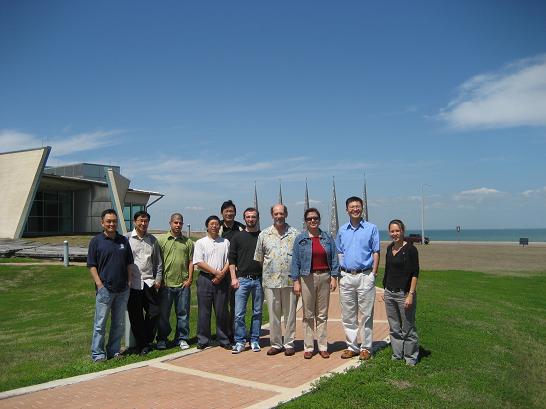Coastal Zone Interdisciplinary Science Project
Using Satellite Data and Fully Coupled Regional Hydrologic, Ecological and Atmospheric Models to Study Complex Coastal Environmental Processes (NNX07AL79G)
Project Summary
| Project Funding: $1,236,978 Funding Period: Principal Investigator: Co-Investigators: Also See: National Center for Atmospheric Research(NCAR) |
This proposal seeks to improve our understanding of how linked upland and estuarine ecosystems respond to combined changes in the hydrological and nutrient cycles that result from changes in climate and land use/ land cover (LULC).
Within this broad framework we will focus on five specific questions:
- What is the relationship between global climate forcing and seasonal-to-interannual climate variability and extreme storm events over the Gulf Coast region?
- What are the spatial patterns in LULC as defined by satellite data in the Gulf Coast region?
- How does riverine nutrient export to Gulf Coast estuaries vary with LULC patterns and hydrologic conditions?
- What is the relationship between the frequency of extreme events in the hydrologic and nutrient cycles and the mean productivity and the resiliency of productivity in Gulf Coast estuaries?
- Can we use the answers to the questions above to predict the response of Gulf Coast estuaries to future climate perturbations?
Extreme weather events are given particular attention in this study because of their dominant influence on hydrological and nutrient dynamics within the Gulf Coast region, and also because such events are typically not well represented in regional scale modeling efforts.
Our group brings together research expertise from a diversity of fields that includes climate modeling, remote sensing analysis, biogeochemical cycling in watersheds, surface hydrology and estuary ecology. To address the above questions we will develop a nested regional atmospheric modeling system augmented with satellite remote sensing data to predict high-resolution spatial and temporal hydrometeorological variables for the Gulf Coast region. At the highest detail level, we will characterize two biologically distinct watersheds in the semi-arid region of Central and South Central Texas, the Nueces River watershed and the San Antonio / Guadalupe watershed using modeling data, existing satellite observations, existing water quality data and new fieldwork. A key consideration in each component of the project will also be an assessment of the uncertainties related to data products and modeling in order to derive confidence values for the model’s predictive capabilities.
Precipitation in the south central United States is highly variable and thus resource availability in Gulf Coast estuaries is highly dependent on the frequency and distribution of extreme hydrological events. This type of climate pattern creates a watershed/estuary dynamic that is different from the terrigenous nutrient driven systems typical of the eastern coast of the US and also different from the ocean dominated systems that typify much of the west coast. In addition to representing a significant portion of the Gulf Coast and other semi-arid coastlines around the world, these types of highly variable systems may be a good model for imminent changes to coastal systems in response to climate change.
Global climate model (GCM) predictions suggest that as climate warms, the Earth will experience an increase in the frequency and intensity of flooding and drought, changes in their spatial occurrence, and a redistribution of water availability on land. Nearly all of these predictions have been carried out on global scale models that have very poor resolution at the regional scale. The frequency and intensity of extreme streamflow events in semi-arid watersheds is also highly influenced by changes in LULC and water management methods such as impoundments and controlled water releases.
Progress
Year 1 Annual Report
Poster Presented at 2009 Ocean Color Research Team (OCRT) Meeting, May 4-6, 2009
Year 2 Team Meeting Presentations (19 March, 2009)
- Overview (Liang Yang)
- Precipitation and LULC change datasets (Hongjie Xie)
- Noah Land Surface Model Development and Its Hydrological Simulations(Guo-Yue Niu)
- Runoff Simulations in Regional 12 (Bryan Hong)
- A Case Study of Continental Water Dynamics in the Guadalupe and San Antonio River Basins (Cedric David)
- Watershed Export and Exturarine Ecosystem Response to Pulsed Inputs of Nitrogen to South Texas Bays (Jim McClelland and Rae Mooney)
- Applications of Landscape Analyses and Ecosystem Modeling to Investigate Land-water Nutrient Coupling Processes in the Guadalupe Estuary, Texas(Sandra Arismendez, Hae-Cheol Kim, Jorge Brenner, and Paul Montagna)
- Future Work (Liang Yang)


